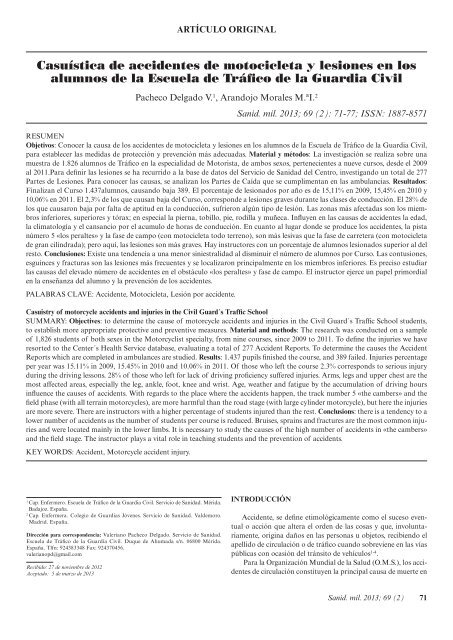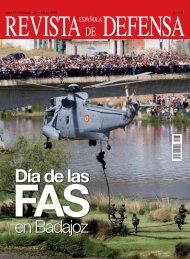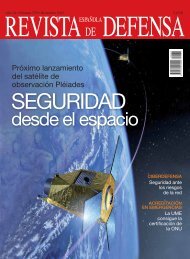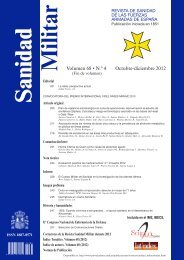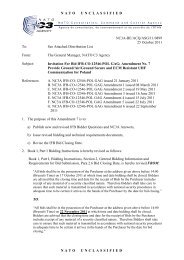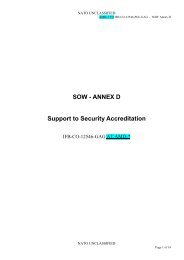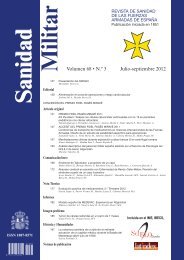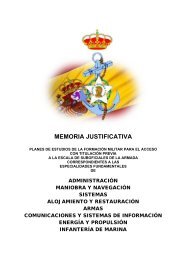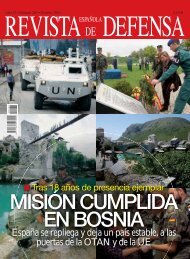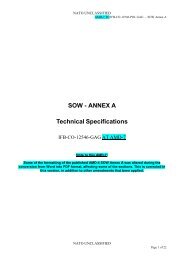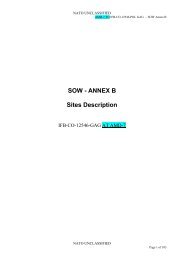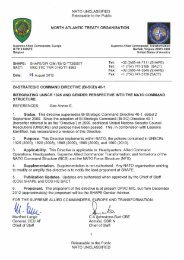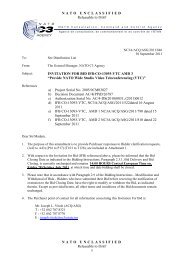ARTÍCULO ORIGINALCasuística <strong>de</strong> acci<strong>de</strong>ntes <strong>de</strong> motocicleta y lesiones en losalumnos <strong>de</strong> la Escuela <strong>de</strong> Tráfico <strong>de</strong> la Guardia CivilPacheco Delgado V. 1 , Arandojo Morales M.ªI. 2Sanid. mil. 2013; 69 (2): 71-77; ISSN: 1887-8571RESUMENObjetivos: Conocer la causa <strong>de</strong> los acci<strong>de</strong>ntes <strong>de</strong> motocicleta y lesiones en los alumnos <strong>de</strong> la Escuela <strong>de</strong> Tráfico <strong>de</strong> la Guardia Civil,para establecer las medidas <strong>de</strong> protección y prevención más a<strong>de</strong>cuadas. Material y métodos: La investigación se realiza sobre unamuestra <strong>de</strong> 1.826 alumnos <strong>de</strong> Tráfico en la especialidad <strong>de</strong> Motorista, <strong>de</strong> ambos sexos, pertenecientes a nueve cursos, <strong>de</strong>s<strong>de</strong> el 2009al 2011.Para <strong>de</strong>finir las lesiones se ha recurrido a la base <strong>de</strong> datos <strong>de</strong>l Servicio <strong>de</strong> <strong>Sanidad</strong> <strong>de</strong>l Centro, investigando un total <strong>de</strong> 277Partes <strong>de</strong> Lesiones. Para conocer las causas, se analizan los Partes <strong>de</strong> Caída que se cumplimentan en las ambulancias. Resultados:Finalizan el Curso 1.437alumnos, causando baja 389. El porcentaje <strong>de</strong> lesionados por año es <strong>de</strong> 15,11% en 2009, 15,45% en 2010 y10,06% en 2011. El 2,3% <strong>de</strong> los que causan baja <strong>de</strong>l Curso, correspon<strong>de</strong> a lesiones graves durante las clases <strong>de</strong> conducción. El 28% <strong>de</strong>los que causaron baja por falta <strong>de</strong> aptitud en la conducción, sufrieron algún tipo <strong>de</strong> lesión. Las zonas más afectadas son los miembrosinferiores, superiores y tórax; en especial la pierna, tobillo, pie, rodilla y muñeca. Influyen en las causas <strong>de</strong> acci<strong>de</strong>ntes la edad,la climatología y el cansancio por el acumulo <strong>de</strong> horas <strong>de</strong> conducción. En cuanto al lugar don<strong>de</strong> se produce los acci<strong>de</strong>ntes, la pistanúmero 5 «los peraltes» y la fase <strong>de</strong> campo (con motocicleta todo terreno), son más lesivas que la fase <strong>de</strong> carretera (con motocicleta<strong>de</strong> gran cilindrada); pero aquí, las lesiones son más graves. Hay instructores con un porcentaje <strong>de</strong> alumnos lesionados superior al <strong>de</strong>lresto. Conclusiones: Existe una ten<strong>de</strong>ncia a una menor siniestralidad al disminuir el número <strong>de</strong> alumnos por Curso. Las contusiones,esguinces y fracturas son las lesiones más frecuentes y se localizaron principalmente en los miembros inferiores. Es preciso estudiarlas causas <strong>de</strong>l elevado número <strong>de</strong> acci<strong>de</strong>ntes en el obstáculo «los peraltes» y fase <strong>de</strong> campo. El instructor ejerce un papel primordialen la enseñanza <strong>de</strong>l alumno y la prevención <strong>de</strong> los acci<strong>de</strong>ntes.PALABRAS CLAVE: Acci<strong>de</strong>nte, Motocicleta, Lesión por acci<strong>de</strong>nte.Casuistry of motorcycle acci<strong>de</strong>nts and injuries in the Civil Guard´s Traffic SchoolSUMMARY: Objectives: to <strong>de</strong>termine the cause of motorcycle acci<strong>de</strong>nts and injuries in the Civil Guard´s Traffic School stu<strong>de</strong>nts,to establish more appropriate protective and preventive measures. Material and methods: The research was conducted on a sampleof 1,826 stu<strong>de</strong>nts of both sexes in the Motorcyclist specialty, from nine courses, since 2009 to 2011. To <strong>de</strong>fine the injuries we haveresorted to the Center´s Health Service database, evaluating a total of 277 Acci<strong>de</strong>nt Reports. To <strong>de</strong>termine the causes the Acci<strong>de</strong>ntReports which are completed in ambulances are studied. Results: 1.437 pupils finished the course, and 389 failed. Injuries percentageper year was 15.11% in 2009, 15.45% in 2010 and 10.06% in 2011. Of those who left the course 2.3% corresponds to serious injuryduring the driving lessons. 28% of those who left for lack of driving proficiency suffered injuries. Arms, legs and upper chest are themost affected areas, especially the leg, ankle, foot, knee and wrist. Age, weather and fatigue by the accumulation of driving hoursinfluence the causes of acci<strong>de</strong>nts. With regards to the place where the acci<strong>de</strong>nts happen, the track number 5 «the cambers» and thefield phase (with all terrain motorcycles), are more harmful than the road stage (with large cylin<strong>de</strong>r motorcycle), but here the injuriesare more severe. There are instructors with a higher percentage of stu<strong>de</strong>nts injured than the rest. Conclusions: there is a ten<strong>de</strong>ncy to alower number of acci<strong>de</strong>nts as the number of stu<strong>de</strong>nts per course is reduced. Bruises, sprains and fractures are the most common injuriesand were located mainly in the lower limbs. It is necessary to study the causes of the high number of acci<strong>de</strong>nts in «the cambers»and the field stage. The instructor plays a vital role in teaching stu<strong>de</strong>nts and the prevention of acci<strong>de</strong>nts.KEY WORDS: Acci<strong>de</strong>nt, Motorcycle acci<strong>de</strong>nt injury.1Cap. Enfermero. Escuela <strong>de</strong> Tráfico <strong>de</strong> la Guardia Civil. Servicio <strong>de</strong> <strong>Sanidad</strong>. Mérida.Badajoz. España.2Cap. Enfermera. Colegio <strong>de</strong> Guardias Jóvenes. Servicio <strong>de</strong> <strong>Sanidad</strong>. Val<strong>de</strong>moro.Madrid. España.Dirección para correspon<strong>de</strong>ncia: Valeriano Pacheco Delgado. Servicio <strong>de</strong> <strong>Sanidad</strong>.Escuela <strong>de</strong> Tráfico <strong>de</strong> la Guardia Civil. Duque <strong>de</strong> Ahumada s/n. 06800 Mérida.España. Tlfn: 924383348 Fax: 924370456.valerianopd@gmail.comRecibido: 27 <strong>de</strong> noviembre <strong>de</strong> 2012Aceptado: 5 <strong>de</strong> marzo <strong>de</strong> 2013INTRODUCCIÓNAcci<strong>de</strong>nte, se <strong>de</strong>fine etimológicamente como el suceso eventualo acción que altera el or<strong>de</strong>n <strong>de</strong> las cosas y que, involuntariamente,origina daños en las personas u objetos, recibiendo elapellido <strong>de</strong> circulación o <strong>de</strong> tráfico cuando sobreviene en las víaspúblicas con ocasión <strong>de</strong>l tránsito <strong>de</strong> vehículos 1-4 .Para la Organización Mundial <strong>de</strong> la Salud (O.M.S.), los acci<strong>de</strong>ntes<strong>de</strong> circulación constituyen la principal causa <strong>de</strong> muerte enSanid. mil. 2013; 69 (2) 71
V. Pacheco Delgado y M.ª I. Arandojo Moralesjóvenes con eda<strong>de</strong>s comprendidas entre los 15 y 30 años 5 . Segúnlos datos que proporciona el Observador Nacional <strong>de</strong> SeguridadVial <strong>de</strong> la Dirección General <strong>de</strong> Tráfico, en España en 2009, 2010y 2011, fallecieron un total <strong>de</strong> 5.012 personas, <strong>de</strong> los que 763 fueronpor acci<strong>de</strong>nte <strong>de</strong> motocicleta 6 . Resulta obvio que el número<strong>de</strong> heridos, en ambos casos, supera con creces al <strong>de</strong> muertos, representandoun alto coste para la sociedad tanto a nivel económicocomo humano.Los agentes integrantes <strong>de</strong> la Agrupación <strong>de</strong> Tráfico <strong>de</strong> laGuardia Civil, tienen como competencia la vigilancia <strong>de</strong>l tráfico,la circulación, el transporte por carreteras y la seguridad vialen su conjunto 7 . Para ello, precisan, entre otros medios, <strong>de</strong> lautilización <strong>de</strong> coches patrulla y motocicletas <strong>de</strong> gran cilindrada.Están expuestos a diario a los múltiples peligros que genera lacarretera, máxime cuando durante la conducción, no sólo atien<strong>de</strong>nal pilotaje <strong>de</strong> su vehículo, sino que a<strong>de</strong>más están pendientes<strong>de</strong> las posibles infracciones y conducción <strong>de</strong>l resto <strong>de</strong> usuarios 8 .Durante los años 2009 al 2011, se produjeron un total <strong>de</strong> 1.795acci<strong>de</strong>ntes en los agentes <strong>de</strong> tráfico, <strong>de</strong> los cuales, 578 fueron convíctimas y hubo un total <strong>de</strong> 12 muertos. La motocicleta fue el vehículoque estuvo implicado con mayor frecuencia en los acci<strong>de</strong>ntescon víctimas, con un total <strong>de</strong> 336; estos datos han sido facilitadospor la Dirección Adjunta Operativa <strong>de</strong> la Agrupación <strong>de</strong> Tráfico.En la Escuela <strong>de</strong> Tráfico <strong>de</strong> la Guardia Civil, en el periodocomprendido entre el año 2009 al 2011, se produjeron un total<strong>de</strong> 422 acci<strong>de</strong>ntes con lesiones, durante el <strong>de</strong>sarrollo <strong>de</strong> las clases<strong>de</strong> conducción <strong>de</strong> motocicleta, según los datos <strong>de</strong> los partes <strong>de</strong>lesiones emitidos por el Servicio <strong>de</strong> <strong>Sanidad</strong> <strong>de</strong>l Centro.Justificación <strong>de</strong>l estudioLos trágicos datos avalan la importancia <strong>de</strong> investigar sobrelas causas <strong>de</strong> los acci<strong>de</strong>ntes <strong>de</strong> motocicleta en la Escuela <strong>de</strong> Tráfico<strong>de</strong> la Guardia Civil al objeto <strong>de</strong> establecer las medidas preventivaso correctoras necesarias, para disminuir la siniestralida<strong>de</strong>ntre en los alumnos motoristas, así como para aplicar estassoluciones al resto <strong>de</strong> los agentes <strong>de</strong> la Agrupación <strong>de</strong> Tráfico y<strong>de</strong>más motoristas <strong>de</strong> la red vial.Es importante también, el estudio <strong>de</strong> las lesiones que se producencomo consecuencia <strong>de</strong> los acci<strong>de</strong>ntes <strong>de</strong> motocicleta; conociéndolas,podremos buscar los elementos pasivos <strong>de</strong> seguridada<strong>de</strong>cuados para evitarlas o al menos minimizarlas.No hay estudios anteriores que analicen la casuística <strong>de</strong> losacci<strong>de</strong>ntes <strong>de</strong> motocicleta y las lesiones en la Escuela <strong>de</strong> Tráfico <strong>de</strong>Guardia Civil. El Servicio <strong>de</strong> <strong>Sanidad</strong> <strong>de</strong>l Centro, en sus memoriasanuales, contabiliza las lesiones sufridas por los alumnos en losdistintos cursos durante el año, sin dar importancia a las causasque las producen. La Dirección General <strong>de</strong> Tráfico informa a nivelestadístico, sobre la siniestralidad propia, abarcando las causasque pue<strong>de</strong>n haber provocado los acci<strong>de</strong>ntes y la gravedad <strong>de</strong> losmismos. No estudia por tanto, la tipología <strong>de</strong> las lesiones, ni hacediferenciación <strong>de</strong> los acci<strong>de</strong>ntes acaecidos en la Escuela.Antece<strong>de</strong>ntes y situación actualEn 1844 el Duque <strong>de</strong> Ahumada fundó a la Guardia Civil,consciente <strong>de</strong> que el principal <strong>de</strong>safío <strong>de</strong>l nuevo Cuerpo era laprotección <strong>de</strong> caminos y viajeros 9 .La construcción <strong>de</strong> carreteras y la aparición paulatina <strong>de</strong> automóvilesy motocicletas cada vez en mayor número, hizo que laGuardia Civil creara el Parque Móvil en 1922. El primer «servicio<strong>de</strong> tráfico» tuvo lugar en 1926, a lo largo <strong>de</strong> 48 Kilómetros<strong>de</strong> la carretera Madrid - La Coruña. La II República y la GuerraCivil, apartó a la Guardia Civil <strong>de</strong> los cometidos <strong>de</strong> vigilancia<strong>de</strong> las carreteras españolas. En la década <strong>de</strong> los 40 se confió lavigilancia <strong>de</strong> éstas, a la Policía Armada. Posteriormente se encomendóa la Guardia Civil, instaurar un servicio motorizado enzonas concretas. Los resultados fueron más que aceptables, loque favoreció la posterior creación <strong>de</strong> la Agrupación <strong>de</strong> Tráfico<strong>de</strong> la Guardia Civil en el año 1959.El I Curso <strong>de</strong> Tráfico se <strong>de</strong>sarrolló en el Centro <strong>de</strong> Instrucción(Madrid), convocándose a los primeros Oficiales y Suboficiales,produciéndose ya las primeras bajas por lesión en laconducción <strong>de</strong> motocicleta. Este personal instruyó al II curso <strong>de</strong>Circulación y Tráfico en la Aca<strong>de</strong>mia Regional <strong>de</strong> El Escorial,para Sargentos, Cabos, Guardias y curiosamente «Practicantes<strong>de</strong> Enfermería» (Cabos o Guardias, con la misión <strong>de</strong> prestar losprimeros auxilios en los acci<strong>de</strong>ntes <strong>de</strong> circulación). Se contó con32 motocicletas marca Lube y 20 Sanglas. Durante las prácticas<strong>de</strong> conducción fallece un alumno, siendo el primer motorista <strong>de</strong>la Agrupación <strong>de</strong> Tráfico muerto en acto <strong>de</strong> servicio.La Aca<strong>de</strong>mia al no tener <strong>de</strong>pen<strong>de</strong>ncias propias, vaga por distintasubicaciones <strong>de</strong> la provincia <strong>de</strong> Madrid.Des<strong>de</strong> el año 1962 hasta 1996, las prácticas <strong>de</strong> conducción serealizaron en unos terrenos <strong>de</strong> la zona militar <strong>de</strong> Campamento<strong>de</strong>stinados a las maniobras <strong>de</strong> carros <strong>de</strong> combate, en Venta laRubia (Madrid). En el año 1996 se traslada a Mérida (Badajoz)y adquiere la <strong>de</strong>nominación <strong>de</strong> Escuela <strong>de</strong> Tráfico. Este Centroya es específico para la obtención <strong>de</strong> la especialidad <strong>de</strong> Tráfico ycuenta con unas mo<strong>de</strong>rnas instalaciones y con sus propias pistas<strong>de</strong> instrucción en la conducción <strong>de</strong> motocicletas 10 .Las motocicletas también han evolucionado en el tiempo:<strong>de</strong>s<strong>de</strong> las primeras y poco seguras Luben Ren y Sanglas 350,hasta las actuales BMW R 1200-RT dotadas con los más mo<strong>de</strong>rnossistemas <strong>de</strong> seguridad. Con respecto a la equipación <strong>de</strong>lmotorista, es importante <strong>de</strong>stacar la evolución <strong>de</strong>l casco comoprincipal elemento <strong>de</strong> su seguridad: <strong>de</strong>s<strong>de</strong> el casco Jet sin homologar(1959), hasta el actual System VI (2011, lleva incorporadaslas transmisiones). Las prendas reflectantes pasaron <strong>de</strong> ser pequeñasbandas en el uniforme <strong>de</strong> servicio, a las actuales prendas,en las que prima el color reflectante. Estas prendas van provistas<strong>de</strong> protecciones en las zonas más vulnerables <strong>de</strong>l cuerpo. Así mismo,el calzado actualmente es el a<strong>de</strong>cuado para la práctica <strong>de</strong> laconducción <strong>de</strong> motocicleta, ya que hasta el año 2010, las botasutilizadas eran las mismas que las <strong>de</strong> equitación 10,11 .Se ha evolucionado en mejoras <strong>de</strong> las pistas <strong>de</strong> conducción,en la dotación <strong>de</strong> mo<strong>de</strong>rnas y más seguras motocicletas y en nuevossistemas <strong>de</strong> seguridad pasiva. No obstante, como muestraeste estudio, es preciso seguir progresando.ObjetivosGeneralConocer las causas <strong>de</strong> los acci<strong>de</strong>ntes <strong>de</strong> motocicleta y lesionesen los alumnos <strong>de</strong> la Escuela <strong>de</strong> Tráfico <strong>de</strong> la Guardia Civil.72 Sanid. mil. 2013; 69 (2)


